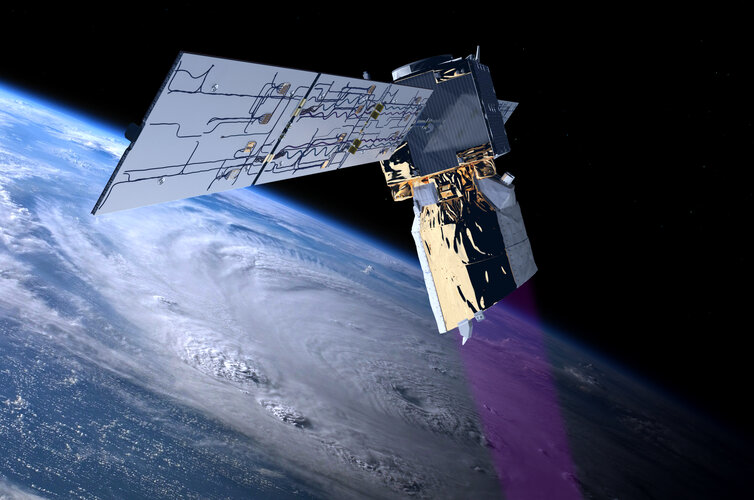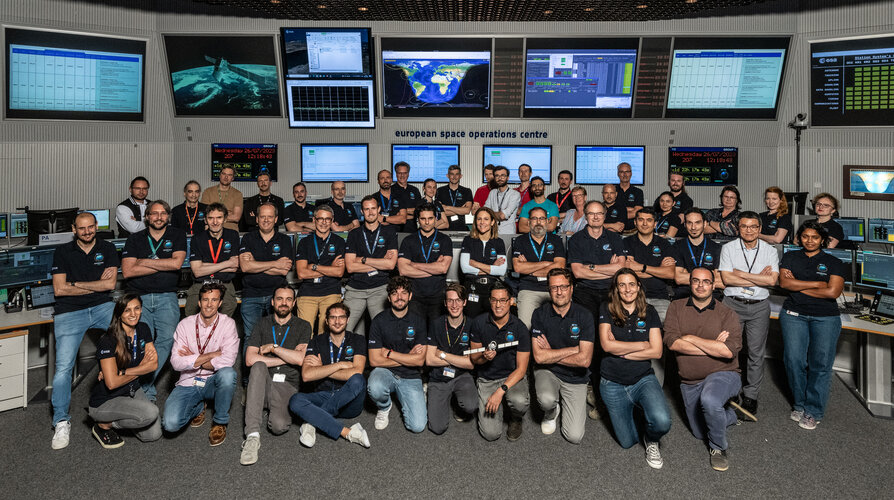
Copernical Team
Saturday, 29 July 2023 06:54
The world's largest ComSat ever built launches on a SpaceX Falcon Heavy rocket
Space Coast FL (SPX) Jul 28, 2023
 SpaceX's Falcon Heavy rocket, launched for the seventh time, was scheduled to lift off on July 26th at 11:04 p.m. EDT, a violation of abort criteria has forced the mission to be scrubbed with 1 minute and 5 seconds left on the clock.
The company had to delay the mission from July 27th "To complete vehicle checkouts".
Hughes Network Systems's Jupiter 3/EchoStar XXIV satellite launched
SpaceX's Falcon Heavy rocket, launched for the seventh time, was scheduled to lift off on July 26th at 11:04 p.m. EDT, a violation of abort criteria has forced the mission to be scrubbed with 1 minute and 5 seconds left on the clock.
The company had to delay the mission from July 27th "To complete vehicle checkouts".
Hughes Network Systems's Jupiter 3/EchoStar XXIV satellite launched
 SpaceX's Falcon Heavy rocket, launched for the seventh time, was scheduled to lift off on July 26th at 11:04 p.m. EDT, a violation of abort criteria has forced the mission to be scrubbed with 1 minute and 5 seconds left on the clock.
The company had to delay the mission from July 27th "To complete vehicle checkouts".
Hughes Network Systems's Jupiter 3/EchoStar XXIV satellite launched
SpaceX's Falcon Heavy rocket, launched for the seventh time, was scheduled to lift off on July 26th at 11:04 p.m. EDT, a violation of abort criteria has forced the mission to be scrubbed with 1 minute and 5 seconds left on the clock.
The company had to delay the mission from July 27th "To complete vehicle checkouts".
Hughes Network Systems's Jupiter 3/EchoStar XXIV satellite launched
Published in
News
Tagged under
Thursday, 27 July 2023 08:10
Historic Aeolus reentry – how it happened

Historic Aeolus reentry – how it happened
Get rolling updates on the Aeolus reentry, on the Rocket Science blog
Published in
News
Tagged under
Saturday, 29 July 2023 05:30
Aeolus: a historic end to a trailblazing mission

Surpassing scientific expectations and exceeding its planned life in orbit, the Aeolus wind mission has been hailed as one of ESA’s most successful Earth observation missions. And now, its end will go down in history too, thanks to the ingenuity of the Agency’s mission control team who guided this remarkable satellite down to Earth’s atmosphere for a safe reentry.
Published in
News
Tagged under
Friday, 28 July 2023 16:21
Aeolus control team wraps up successful reentry operations
 Image:
Aeolus control team wraps up successful reentry operations
Image:
Aeolus control team wraps up successful reentry operations
Published in
News
Tagged under
Friday, 28 July 2023 11:55
Iridium Board of Directors approves additional share repurchase program
McLean VA (SPX) Jul 28, 2023
 Iridium Communications Inc. (Nasdaq: IRDM) reported Thursday that its Board of Directors has authorized the repurchase of an additional $400 million of Iridium common stock through December 31, 2025.
This is the third stock repurchase authorization from the Board of Directors in the past three years and brings the total value of the program to $1 billion. This $400 million authorization is
Iridium Communications Inc. (Nasdaq: IRDM) reported Thursday that its Board of Directors has authorized the repurchase of an additional $400 million of Iridium common stock through December 31, 2025.
This is the third stock repurchase authorization from the Board of Directors in the past three years and brings the total value of the program to $1 billion. This $400 million authorization is
 Iridium Communications Inc. (Nasdaq: IRDM) reported Thursday that its Board of Directors has authorized the repurchase of an additional $400 million of Iridium common stock through December 31, 2025.
This is the third stock repurchase authorization from the Board of Directors in the past three years and brings the total value of the program to $1 billion. This $400 million authorization is
Iridium Communications Inc. (Nasdaq: IRDM) reported Thursday that its Board of Directors has authorized the repurchase of an additional $400 million of Iridium common stock through December 31, 2025.
This is the third stock repurchase authorization from the Board of Directors in the past three years and brings the total value of the program to $1 billion. This $400 million authorization is
Published in
News
Tagged under
Friday, 28 July 2023 11:55
Beyond Gravity to provide off-the-shelf computer to Quantum Space's Ranger multi-purpose vehicle
Zurich, Switzerland (SPX) Jul 28, 2023
 Beyond Gravity, a leading supplier to the space industry, will provide its constellation On Board Computer (cOBC) to Quantum Space's inaugural flight of its Ranger multi-purpose vehicle, which will take payloads to geostationary and cislunar orbits.
Beyond Gravity, a leading supplier to the space industry, has announced it will provide its constellation On Board Computer (cOBC) to Quantum
Beyond Gravity, a leading supplier to the space industry, will provide its constellation On Board Computer (cOBC) to Quantum Space's inaugural flight of its Ranger multi-purpose vehicle, which will take payloads to geostationary and cislunar orbits.
Beyond Gravity, a leading supplier to the space industry, has announced it will provide its constellation On Board Computer (cOBC) to Quantum
 Beyond Gravity, a leading supplier to the space industry, will provide its constellation On Board Computer (cOBC) to Quantum Space's inaugural flight of its Ranger multi-purpose vehicle, which will take payloads to geostationary and cislunar orbits.
Beyond Gravity, a leading supplier to the space industry, has announced it will provide its constellation On Board Computer (cOBC) to Quantum
Beyond Gravity, a leading supplier to the space industry, will provide its constellation On Board Computer (cOBC) to Quantum Space's inaugural flight of its Ranger multi-purpose vehicle, which will take payloads to geostationary and cislunar orbits.
Beyond Gravity, a leading supplier to the space industry, has announced it will provide its constellation On Board Computer (cOBC) to Quantum
Published in
News
Tagged under
Friday, 28 July 2023 11:55
Historic MWA milestone reached as we go 'back to the future' in the cosmos
Perth, Australia (SPX) Jul 27, 2023
 A world-class telescope in outback Western Australia is on the verge of unlocking more secrets from the start of the Universe as new technology upgrades are rolled out during its historic 10-year anniversary. The Murchison Widefield Array (MWA) project, a powerful telescope made up of 8,192 antennas spread across more than 30sqkm on Wajarri Yamatji land, about 300km north-east of Geraldton, is c
A world-class telescope in outback Western Australia is on the verge of unlocking more secrets from the start of the Universe as new technology upgrades are rolled out during its historic 10-year anniversary. The Murchison Widefield Array (MWA) project, a powerful telescope made up of 8,192 antennas spread across more than 30sqkm on Wajarri Yamatji land, about 300km north-east of Geraldton, is c
 A world-class telescope in outback Western Australia is on the verge of unlocking more secrets from the start of the Universe as new technology upgrades are rolled out during its historic 10-year anniversary. The Murchison Widefield Array (MWA) project, a powerful telescope made up of 8,192 antennas spread across more than 30sqkm on Wajarri Yamatji land, about 300km north-east of Geraldton, is c
A world-class telescope in outback Western Australia is on the verge of unlocking more secrets from the start of the Universe as new technology upgrades are rolled out during its historic 10-year anniversary. The Murchison Widefield Array (MWA) project, a powerful telescope made up of 8,192 antennas spread across more than 30sqkm on Wajarri Yamatji land, about 300km north-east of Geraldton, is c
Published in
News
Tagged under
Friday, 28 July 2023 11:55
NASA Completes First Launch Simulation for Artemis II Moon Mission
Kennedy Space Center FL (SPX) Jul 27, 2023
 NASA's Artemis launch team conducted its first simulation for Artemis II, the first crewed mission under Artemis, on July 20 inside the Launch Control Center at the agency's Kennedy Space Center in Florida.
As NASA teams prepare to send the crew of four astronauts on a journey around the Moon and bring them back safely, they will participate in a wide range of simulations to ensure personn
NASA's Artemis launch team conducted its first simulation for Artemis II, the first crewed mission under Artemis, on July 20 inside the Launch Control Center at the agency's Kennedy Space Center in Florida.
As NASA teams prepare to send the crew of four astronauts on a journey around the Moon and bring them back safely, they will participate in a wide range of simulations to ensure personn
 NASA's Artemis launch team conducted its first simulation for Artemis II, the first crewed mission under Artemis, on July 20 inside the Launch Control Center at the agency's Kennedy Space Center in Florida.
As NASA teams prepare to send the crew of four astronauts on a journey around the Moon and bring them back safely, they will participate in a wide range of simulations to ensure personn
NASA's Artemis launch team conducted its first simulation for Artemis II, the first crewed mission under Artemis, on July 20 inside the Launch Control Center at the agency's Kennedy Space Center in Florida.
As NASA teams prepare to send the crew of four astronauts on a journey around the Moon and bring them back safely, they will participate in a wide range of simulations to ensure personn
Published in
News
Tagged under
Friday, 28 July 2023 11:55
Sol 3898: A Stop Along the Road
Pasadena CA (JPL) Jul 24, 2023
 Earth planning date: Monday July 24, 2023: Today's single sol plan takes us further into our road trip through the Jau crater cluster. Like any road trip, we're taking frequent stops to take in the sights, and at this spot Curiosity gets to stretch its arm with a touch and go. It reminds me of being on family road trips with my geologist father - we were always pulling over to look at cool rocks
Earth planning date: Monday July 24, 2023: Today's single sol plan takes us further into our road trip through the Jau crater cluster. Like any road trip, we're taking frequent stops to take in the sights, and at this spot Curiosity gets to stretch its arm with a touch and go. It reminds me of being on family road trips with my geologist father - we were always pulling over to look at cool rocks
 Earth planning date: Monday July 24, 2023: Today's single sol plan takes us further into our road trip through the Jau crater cluster. Like any road trip, we're taking frequent stops to take in the sights, and at this spot Curiosity gets to stretch its arm with a touch and go. It reminds me of being on family road trips with my geologist father - we were always pulling over to look at cool rocks
Earth planning date: Monday July 24, 2023: Today's single sol plan takes us further into our road trip through the Jau crater cluster. Like any road trip, we're taking frequent stops to take in the sights, and at this spot Curiosity gets to stretch its arm with a touch and go. It reminds me of being on family road trips with my geologist father - we were always pulling over to look at cool rocks
Published in
News
Tagged under


